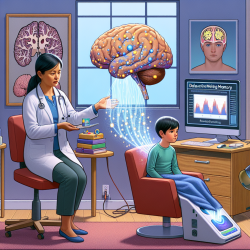Introduction
In the ever-evolving field of speech-language pathology, practitioners are constantly seeking innovative approaches to improve therapeutic outcomes. A recent study titled "Prediction of Declarative Memory Profile in Panic Disorder Patients: A Machine Learning-Based Approach" offers intriguing insights that could be leveraged to enhance our practice, particularly when working with children who exhibit memory and cognitive challenges.
Understanding the Research
The study employs a machine learning technique known as Random Forest (RF) modeling to predict declarative memory profiles in patients with panic disorder (PD). By analyzing data from the Rey Auditory Verbal Learning Test (RAVLT), the researchers developed models that could successfully classify memory profiles with high accuracy. Notably, the study found that factors such as age, body mass index (BMI), and socioeconomic status play significant roles in memory performance.
Implications for Speech-Language Pathologists
While the study focuses on adults with panic disorder, the methodologies and findings have potential applications in pediatric speech-language pathology. Here are some ways practitioners can integrate these insights into their practice:
- Data-Driven Assessment: Utilize machine learning models to enhance the assessment of memory and cognitive functions in children. By understanding the factors influencing memory, practitioners can tailor interventions more effectively.
- Personalized Interventions: Consider factors such as age and BMI when designing therapy plans. Recognizing the impact of these variables can lead to more personalized and effective interventions.
- Collaboration with Data Scientists: Collaborate with data scientists to develop predictive models tailored for pediatric populations. This can help in early identification of children at risk of cognitive impairments.
Encouraging Further Research
While the study provides a solid foundation, further research is needed to adapt these models for use with children. Speech-language pathologists are encouraged to engage in collaborative research efforts to explore the applicability of machine learning in pediatric settings. By doing so, we can expand our understanding of cognitive development and improve outcomes for children with speech and language disorders.
Conclusion
The integration of machine learning techniques into speech-language pathology holds great promise for advancing our practice. By leveraging data-driven insights, we can enhance our assessments, tailor interventions, and ultimately create better outcomes for children. As we continue to explore these possibilities, collaboration and research will be key to unlocking the full potential of these innovative approaches.
To read the original research paper, please follow this link: Prediction of declarative memory profile in panic disorder patients: a machine learning-based approach.










